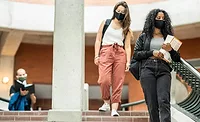Balancing Technology and the Human Side of School Security
Columbine, Virginia Tech, Sandy Hook – These schools are household names around the U.S., but not necessarily for their academics, athletics or famous alumni.

|
Columbine, Virginia Tech, Sandy Hook – These schools are household names around the U.S., but not necessarily for their academics, athletics or famous alumni. These schools, their students and their communities are some of the most famous victims of school shootings in the past 20 years. And while there has been increased media attention on violence in schools, experts are warning stakeholders – and security leaders – to take rational, not emotional, action, especially when managing the human side of school security.
Getting the Facts
“There is no federal mandatory school crime reporting and tracking for preK-12 schools, so we really don’t know in hard numbers what type of school violence trends really exist because there is no uniform national incident-based data collection,” says Ken Trump, MPA, President of National School Safety and Security Services. “Government statistics grossly underestimate the extent of school violence, public perception tends to overstate it, and reality exists somewhere in between – but nobody knows exactly where that ‘somewhere’ is because of the lack of uniform data.
“We certainly know that school crime and violence occurs,” he adds. “On a day-to-day basis, the greatest threat in most schools may be bullying and related aggressive behavior. But schools also have to prepare for a continuum of threats ranging from bullying and aggressive behavior on one end to weather and natural disasters, stabbings, shootings and even terrorism on the other end of the continuum. With a continuum of threats must come a continuum of prevention, intervention, security and emergency preparedness measures.”
According to Dr. Scott Poland, professor and co-director of the Suicide and Violence Prevention Office at Nova Southeastern University in Fort Lauderdale, Fla., and one of the founding members of the National Emergency Assistance Team for the National Association of School Psychologists, the reaction of a school and a community post-incident can be drastic, and often uneven. “You often see an addition of hardware measures – things you can see like cameras, better locks, school resource officers (SRO) – but we fail to focus on non-hardware measures like smaller classrooms, relationship building, counselors, psychologists, anger management, safety taskforces, students surveys and bullying prevention.”
Why spend security budgets on these programs? Consider this: According to the Safe School Initiative’s report from the U.S. Secret Service, 71 percent of school shooters from 1973 to 2000 felt bullied, persecuted, threatened, attacked or injured by others prior to the incident. Only one-third of them ever received a mental health evaluation, despite the fact that their behavior had concerned others (including peers and adults) 93 percent of the time.
The Human Side
“There must be balance between the human and hardware sides of school security,” says Trump. “That balance has been out-of-whack since the Sandy Hook Elementary School shootings as schools have rushed to physical security measures, primarily in the form of equipment such as cameras and access control, while largely ignoring the human side of school safety. There is a competition for time as much as there is for money when it comes to school safety, and too many school administrators and boards are falsely under the impression that if they throw money in a one-time shot to fortify the front entrance, hang up a few cameras, they can point to those to appease parental anxiety and create the impression they have done something meaningful to really make the schools safer.”
Trump adds that other aspects of the “human side of school security” include SROs who build positive relationships with students, providing mental health support and training school staff – not just teachers but support staff such as secretaries, custodians, bus drivers and food service staff – on emergency guidelines, drills and crime prevention practices.
“The human side also means working with first responders, mental health professionals and others to create, update and test written plans to see if they might work in a real emergency,” Trump says. “Drills need to be conducted not for adults’ convenience, but for reality. This means blocking exits during fire drills, doing lockdown drills during lunch and between class changes, and similar strategies to train educators and students to think on their feet.”
De-escalation or crisis intervention training has been proven effective also – in August 2013, Antoinette Tuff, an employee in the front office of Ronald E. McNair Discovery Learning Academy outside Atlanta, talked down a gunman with an AK-47-type weapon, who was then taken into police custody. Tuff, due to regular training for hostile situations, signaled a code to two coworkers, who triggered a phone tree to tell teachers to lock-down the school, all while Tuff worked to keep the gunman calm. According to school district spokesman Quinn Hudson in a CNNarticle, “The training is so often and extensive, they thought it was a drill” at first.
According to Paul Timm, PSP, President of RETA Security, a school security consulting firm, schools often follow the first law of loss prevention: “Effective loss prevention is always preceded by extreme losses,” but it doesn’t have to be like that. By practicing multifaceted, proactive security, security leaders can build comprehensive, collaborative programs to involve all necessary stakeholders – including students – in security initiatives.
“You shouldn’t assume that counselors have violence prevention and intervention under control,” says Timm. “Focus on staff training – teachers and other staff need the mechanism of awareness training, emergency planning and documented practices. Often, schools have ‘unwritten’ security or awareness practices, but those do you no good after an event, especially for liability.”
Collaboration is key, he adds. “Nobody has shoulders broad enough to carry the security program alone. Many security directors have the ‘lone ranger’ mentality from a history in law enforcement, and they might assume that students are just the bad guys, but students, teachers and staff all want to be safe on campus, and you should work with them.”
A large part of that collaboration is building trust.
Earn Trust to Build Trust
According to the Safe School Initiative, in 81 percent of targeted school shooting incidents, at least one person had prior knowledge of the attack. In 93 percent of those cases, the person who knew was a peer, friend, schoolmate or sibling. This is known as Third-Party Leakage.
Workplace violence prevention consultant and trainer Dr. Steve Albrecht says that in order to suppress the “no snitch” culture among students and to start receiving intelligence about potential incidents, schools should put multiple reporting methods in place. Anonymous tip-lines, monitored by school councilors (who know the context or could identify certain students more than law enforcement), could start to bridge the communication gap. “You have to expect the goofy calls and evaluate each tip’s validity, but for every 10 prank tips, you might get one valuable piece of information. It’s worth it,” he says.
At Virginia Tech, community engagement is the cornerstone of the VT Threat Management program. An effective reporting system features multiple layers of gatekeepers, says Gene Deisinger, Deputy Chief of Police and Director of Threat Management for Virginia Tech, but all reports make their way to his office. For example, a student teaching assistant – typically a graduate student – has specific concerns about a student or colleague. That assistant can consult with a professor, department chair, the police department or the threat assessment team directly, but all reports are sent into the team. This way, the reporter can address their concerns to someone they know and trust to act appropriately with the information.
“The fourth ‘R’ in education (alongside Reading, Writing and Arithmetic) today is ‘relationships,’” says Trump. “School staff needs to have positive professional relationships with students. This is how we learned about weapons brought to school, planned plots and other violence threats. They also must have relationships with their community partners: Police, fire, EMS, emergency management, mental health and other governmental and community-based agencies. And they must have strong relationships and communications with parents.”
Schools can start to gather information through the relationships students have with their coaches and teachers, says Timm. The Safe School Initiative report states that 44 percent of attackers were involved in some organized social activities in or outside of school, including sports teams, school clubs, extracurricular activities and mainstream religious groups. Forty-one percent of attackers were considered mainstream students, or socialized with mainstream students. The majority of attackers were doing well in school, unlike the stereotypical profile of shooters as “problem” students.
According to the report, “Educators and other adults can learn how to pick up on these signals (such as indicators of violence or peers’ concerns) and make appropriate referrals. By inquiring about any information that may have prompted some concern, an investigator may be able to develop a more comprehensive picture of the student’s past and current behavior, and identify any indications that the student is intent on or planning to attack.”
“School security is an inside job,” says Poland. “Virtually every school shooting by a student could have been prevented.” He recommends that schools require SROs to get out of their cars and patrol the school, talking with students instead of interrogating them, building a connection and basis of trust, especially early in a student’s career. Counselors at the K-12 level spend the majority of their time on scheduling or clerical issues instead of students’ personal issues, he says, which underutilizes a strong channel of outreach to students.
Students could also be elected as “school safety representatives,” who, every week, join other representatives for safety meetings during study periods to discuss initiatives or threats they’ve heard or been told by peers, reporting to a teacher or administrator, Poland adds.
In addition to Safety Taskforces, schools should create internal Threat Assessment teams. These teams, separate from a safety taskforce, should be used to get as much data about a potential threat as possible to then decide a course of action as a group.
According to Timm, these teams should be small, internal and confidential, and the team should work to build an awareness level about threats within the school or district. He recommends no more than seven members, involving a facility director, security director, someone in a mental health role, an administrator and, in certain districts, a community liaison officer. Schools could also involve an attorney who is well-versed in school law and confidentiality requirements.
To Deisinger, the key to all of these efforts is awareness.
"We focus on outreach. We emphasize websites and training materials that are passively available and easy to access, but more importantly, our threat management representatives are out in the community doing presentations and engaging the community in the issues. I never leave an outreach event without a new referral. We listen for concerns and feedback.
“The ostrich approach to school/campus security is probably not the lawful approach, and it’s definitely not the best for students, faculty or staff. Build your program to a standard of care for students and staff.”
Resources
Need more information or statistics on the human side of school security?
We recommend the following resources:
- Gallagher Post
- International Association of Chiefs of Police (IACP)
- McGruff.org
- National Association of School Psychologists
- National Association of School Resource Officers
- National Center for Campus Public Safety
- National Crime Prevention Council
- School Safety Centers (available on the national or state level)
- School Safety News Channel (Facebook.com/schoolsafety)
- U.S. Department of Education
- U.S. Secret Service Safe School Initiative
Need help introducing your administration to your initiatives? These are a few examples of grant programs that can help boost your funding without taxing the school district’s budget:
- AT&T Grants Support Program
- Community Oriented Policing Services (COPS)
- Homeland Security Grant Program: www.grants.gov
- U.S. Cellular: Calling All Communities
What resources have been the most useful for you?
Tell us online at www.SecurityMagazine.com, or contact us on Twitter @SecurityMag
Looking for a reprint of this article?
From high-res PDFs to custom plaques, order your copy today!







